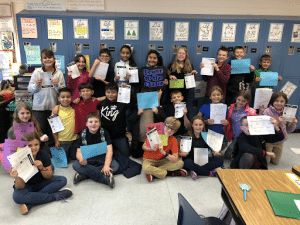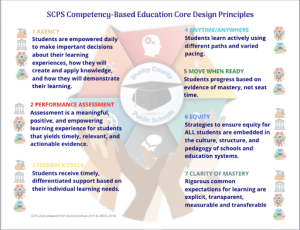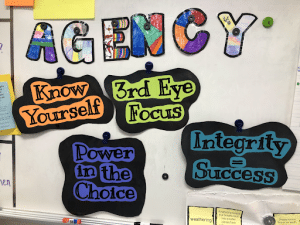The Drive Towards Student Agency: Empowering Students to Make Choices on Their Learning Pathway
CompetencyWorks Blog
The First Agency Meeting
It was 1:30 on a Thursday afternoon in September 2021 in my 4th grade classroom. I had spent the last year considering how I could shift my pedagogy to ensure that my students were active participants in their learning and not merely passive passengers. I wanted to give this developing idea the energy it deserved, so I turned to the experts in the room. To convey the importance of this meeting and signal that I placed value on every voice in the room, I ensured we had a clean workspace and adjusted the tables so that all students could be seen. I asked my students to sit with me.
I started this meeting by asking: “What should school feel like?” As anyone could imagine, I didn’t see a flood of hands lift into the air with excitement. Instead, I received blank stares and confusion as to why I was asking the question in the first place. At this moment, I allowed the silence to rest with us. I realized how vital it was to change things. My students deserve to have an experience that works for them. An education system built to authentically personalize their learning so that they fully felt and were in charge of their growth. Slowly, brave students raised their hands.
Students spoke of a space where they had an opportunity to explore and felt trusted to make choices that were valued by all. They want to reach out into the world they see and know how to connect. They want to collaborate, create, and design authentic solutions to problems. Before long, my students painted a picture of a classroom that I wanted to be a part of. Now, it was my time to bring their ideas into the academic world of school.
My Calling
I started teaching in 2011, where I was exposed to methods of pedagogy like the Workshop Model and Thinking Strategies. They were meant to help support deeper learning for my students, however, something was missing. I felt an evolution beginning in our education system, but I knew something had not been fully realized. I was still searching for it as we began to flip from the established framework of education to a new student-centered and -driven system. It was important for me to maintain a focus on critical thinking and applying mastery within the standards as I began to shift my pedagogy.
 I implemented these methods in my classroom across school years, utilizing a set program, teacher-designed units, and restrictive grading practices. I watched my students continue to be passive participants in their education. Unengaged. I quickly learned that if I wanted to make a real impact, the students would need to become fully engaged partners in their learning. They needed to understand at a deep level the impact that their decisions have on their own learning pathway.
I implemented these methods in my classroom across school years, utilizing a set program, teacher-designed units, and restrictive grading practices. I watched my students continue to be passive participants in their education. Unengaged. I quickly learned that if I wanted to make a real impact, the students would need to become fully engaged partners in their learning. They needed to understand at a deep level the impact that their decisions have on their own learning pathway.
Through professional development offered by my district and my search for alternative learning structures, I found competency-based education. After diving deep into this system of learning, I knew I had found what I was looking for. But how should I begin? I wanted my students to see “the why” of learning. But what tools do I need to achieve this? I wanted my students to understand the purpose behind standards and strategies that allowed them to work with the concepts on a deeper level. But how do I give them the keys to unlock this kind of learning? After careful consideration and support from my administration, I knew small, simple shifts could be made. I started by ensuring that my students felt empowered, allowing them to make choices and reflect on those choices. I chose to commit to giving them the time and space they needed to do so.
It was vital that my students understood their value – not only in my classroom, but in the world. I knew that student academic agency was the answer.
 Agency Meetings Evolved
Agency Meetings Evolved
Once I knew I needed to establish the concept of academic agency in our classroom culture, I knew it would be imperative to give this concept the time it needed. I became more intentional with a variety of modes of reflection so that all students could build concrete examples of what this abstract noun means to them. Students began to reflect as a class, then within small groups as well as individually on their process throughout the day. The idea of an agency meeting slowly developed as students pulled out the need to reflect on their own decisions. By reflecting on successes and failures and what led them there, my students began to own their decisions throughout their learning process.
Once established, our meetings started with a simple reflection question: “What agency decisions did you make today that impacted your learning?” I watched as brave students began to raise their hands and identify big and small moments throughout their day where they felt themselves make a decision. At the beginning of the year, agency decisions looked like “staying on task” or “being kind to a friend,” but soon, these decisions evolved into “rereading a text” or “using a second strategy to check my thinking.” The more students grasped the idea of good decision-making skills the more they began to own their decisions. It was a simple shift to a values-based system where students identified the good decisions and the bad decisions. I harnessed what was said in these meetings. It was my job to validate what was said. I became intentional about capturing the student voice and making it visible. 
By the end of my first year of intentionally teaching agency within my classroom, I discovered that my students had taken over. Agency meetings were planned without me. Students began to start reflecting on their learning pathway without being prompted. By April of that year, I knew I had stumbled upon something valuable. I found some natural processes that humans need in order to grow. The concept of agency lives within every person. By May, my students created a plan that even I wasn’t anticipating – a plan to establish a legacy and ensure the next class of fourth graders would learn agency, too.
Agency and Student Choice
It takes trust. To truly give students the time they need to make mistakes in order to know what good decisions feel like, it takes trust. Now student academic agency has evolved into passion projects, student-led lessons, and standard continuums reflections. My students are making choices that are meaningful and valued. They are sharing their learning and passions with their peers and connecting their learning pathway to standards. As I look back on the past three years I realize now I’m living in the picture my students painted in September of 2021.
Learn More
- Mrs. Seely’s Classroom Website
- Together We Shine Brighter: A Teacher’s Insights from #Aurora23
- Beyond Packaging: Manifesting Mastery-Based Learning in the Classroom at TYWLS of Astoria
 Morgan Seely is a 4th grade teacher in Shelby County Kentucky. She began teaching in 2011 and recently discovered a new passion for competency-based educational practices. Morgan strives to make innovative moves in her daily practice so that she can create an authentically student-centered learning environment.
Morgan Seely is a 4th grade teacher in Shelby County Kentucky. She began teaching in 2011 and recently discovered a new passion for competency-based educational practices. Morgan strives to make innovative moves in her daily practice so that she can create an authentically student-centered learning environment.
